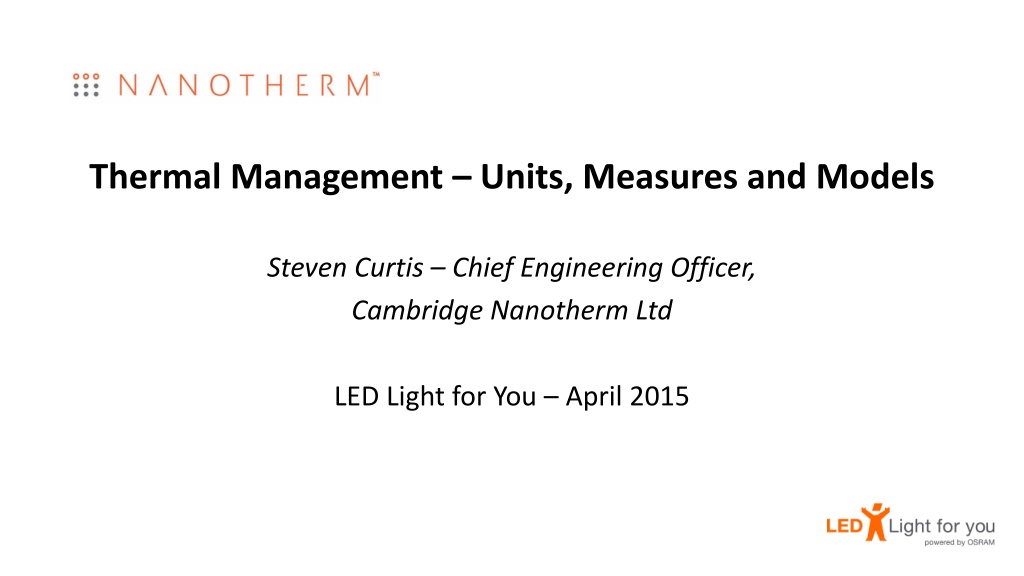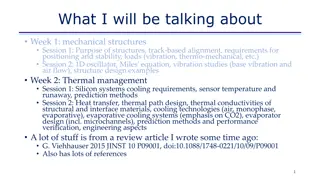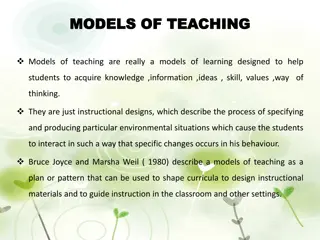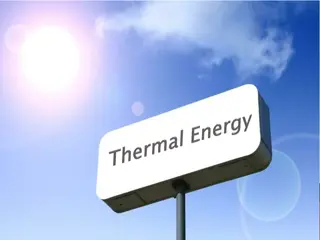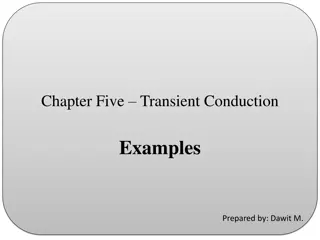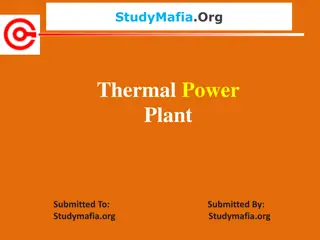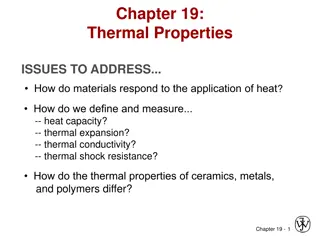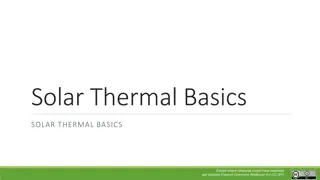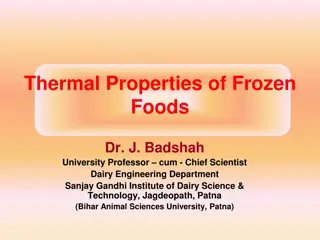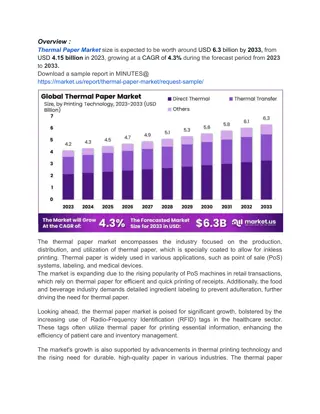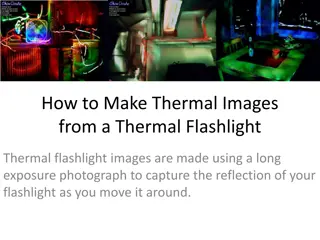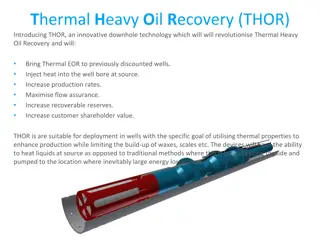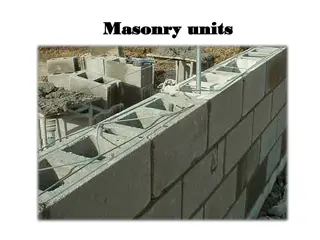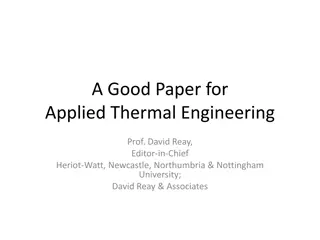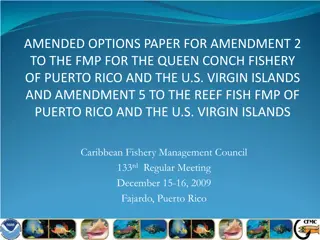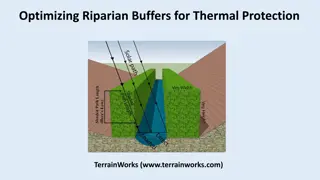Thermal Management Units, Measures, and Models
In this article, learn about thermal management units, measures, and models essential for engineers in the LED industry. Explore concepts like thermal conductivity, thermal resistance, and how to make informed decisions when selecting materials based on their thermal properties. Dive into calculations for thermal resistance using different dielectric thicknesses and material conductivities to understand their impact on heat transfer. Gain insights into the intricacies of thermal management in LED applications.
Uploaded on Feb 24, 2025 | 0 Views
Download Presentation

Please find below an Image/Link to download the presentation.
The content on the website is provided AS IS for your information and personal use only. It may not be sold, licensed, or shared on other websites without obtaining consent from the author. Download presentation by click this link. If you encounter any issues during the download, it is possible that the publisher has removed the file from their server.
E N D
Presentation Transcript
Thermal Management Units, Measures and Models Steven Curtis Chief Engineering Officer, Cambridge Nanotherm Ltd LED Light for You April 2015
Thermal Management Knowledge Thermal Management An art? A science? Pure Black Magic? Tier 1 LED Manufacturers & Mega-corps - Invested in strong engineering teams Mid-to-Large Corporations (250+ employees) Limited exposure to thermal management tool kit - Electrical, mechanical, simulation and test resources - Varying skill sets Thermal Eng generally outsourced - Small business - Good facilities with well kitted labs and suites
Units and measures W/mK thermal conductivity (k), the ability of a material to transfer heat through it, a bulk property of a material K/W thermal resistance (Rth), the resistance to heat flow exhibited by a material, a property relating to a given physical form of a material When looking at a data sheet, which is the correct figure to work with? A lot of decisions still based on the headline figure - the 5W/mK is better than the 3W/mK material , but this is flawed .
Which material? 10W/mK MCPCB Chinese MCPCB highly filled epoxy dielectric 3W/mK MCPCB Leading MCPCB type for HB LED (filled epoxy) 1W/mK MCPCB standard entry-level MCPCB (filled epoxy) 0.3W/mK MCPCB - Steve s super-special MCPCB (B&Q own brand carpet tile adhesive) Looking at these figures, it s a no-brainer, I ll take the 10W/mK please (Caveat: assuming price, mechanical and electrical properties are the same for all) Let s just think that one through first .
Which material? (2) Let s calculate the thermal resistance of each of these material To do that we need to know the crucial missing piece of data - dielectric thickness; 10W/mK material 200 micron 3W/mK material 50 micron 1W/mK material 100 micron 0.3W/mK material 3 micron
Thermal resistance Let s calculate the thermal resistance* of each of these material. To do that we need to know the crucial missing piece of data - dielectric thickness (t); 10W/mK material 200 micron 3W/mK material 50 micron 1W/mK material 100 micron 0.3W/mK material 3 micron Rth = 0.29K/W Rth = 0.21K/W Rth = 1.1K/W Rth = 0.18K/W Rth = t / kA *Assumes 1oz Cu and 1.5mm Al base material. Calculated on 1cm2 substrate area (A)
Thermal resistance of a system When you start putting a luminaire together, the thermal resistance of the system is the sum of all individual component thermal resistances .represented here by their electrical counterpart. Pd Rth-die MCPCB Don t forget that it is not just the layers which have a thermal resistance, but the interfaces between them! Even down to the interface between the MCPCB Cu layer and its dielectric Rth-MCPCB Rth-TIM In the most basic of models, this then allows you to calculate the LED die junction temperature (Tj) - given that you know the thermal resistance, ambient temperature and electrical power; Rth-HS So, Tj = Ta+(Rth-total x Pd)
So thats it job done?! Well, not quite Thermal resistance is only part of the equation, the other half is thermal capacity. Each material layer in the system has a capacity, an ability, to accept and store heat. If we expand our simple thermal model we now have our thermal capacitors in the string. Now the maths starts to get more complex! Thermal capacity, as well as depending upon a materials thermal conductivity, also depends upon it s size/mass. An Al heat sink has a much higher thermal capacity than a MCPCB dielectric. Pd Cth-die Rth-die MCPCB Cth-MCPCB Rth-MCPCB Cth-TIM Rth-TIM Cth-HS Rth-HS
How can we visualise this easily? Luckily, those clever maths guys have figured out a simple graph for us. It s called the cumulative structure function, to the ley person, it is a graph of thermal capacity v. thermal resistance.
Understanding the C v R graph Every time you encounter a thermal resistance the graph moves horizontally, every time you encounter a thermal capacitor the graph moves vertically. We know from our simple thermal model showing the string of Thermal Resistors and Thermal Capacitors that all materials posses an element of both, therefore, all elements are lines of various gradients. TIM Cth Aluminium 3W/mK Dielectric 2oz Copper AuSn Die Attach Semiconductor Rth Total Rth
How do I optimise my luminaire design using the C v R method? A hierarchy exists in these simple models the importance of good thermal conductivity/low thermal resistance is higher at the die end of the chain. Consider the hose pipe analogy! A design can fall into three categories; Materials have been under-specified and high thermal resistances mean that you have your components running hot and component life reduced. Materials have been over-specified and you have ice cold components, but a luminaire that costs a fortune. Materials optimised for the required power dissipation - well done!
The optimised graph In over-specifying your die end materials, you ve done a great job thermally but you may have blown your budget for the project. In under-specifying your die end materials you re now playing catch-up with your Thermal interface material (TIM) and heat sink. The optimal path lies on a diagonal line between these, whose gradient is dependent upon the power that needs to be dissipated. Cth Rth-OS Rth-Opt Rth-US Over spec nanoAg die attach, 5W/mK MCPCB Under spec epoxy die attach, 1W/mK MCPCB Rth
The optimised graph In over-specifying your die end materials, you ve done a great job thermally but you may have blown your budget for the project. In under-specifying your die end materials you re now playing catch-up with your Thermal interface material (TIM) and heat sink. The optimal path lies on a diagonal line between these, whose gradient is dependent upon the power that needs to be dissipated. Cth Rth-OS Rth-Opt Rth-US Need a much better MCPCB dielectric!!! Over spec nanoAg die attach, 5W/mK MCPCB Under spec epoxy die attach, 1W/mK MCPCB Rth
Watch out for Signs of under specifying Hot components! Falling into the trap of having to increase Cu layer on MCPCB to gain capacity and heat-spreading in this layer. Increasing the MCPCB Aluminium thickness. Improving your TIM material and enlarging your heat sink doesn t have as big an effect as expected. Signs of over specifying Huge reductions in Tj, beyond what is reasonable required. The marketing guy is telling you that your competitors are half the price.
All very well in theory, but how do I get my Tj? Your options; Use the thermal resistance data from data sheets to calculate Rth-total and then Tj. Dependent upon accuracy (aka honesty!) of data sheet figures, requires no experimental set- up. Measure using thermocouples on solder points quick, easy, but you ll not get to the actual junction temperature. Use an IR camera to look at the LED Again, fairly easy to do, but beware that all materials in front of the die (phosphor, encapsulation) have different emissivities and this can skew the readings. Use a source-and-measure approach (JEDEC JESD51) to measure Forward Voltage (Vf) which is directly proportional to the junction temperature (Tj) Requires high specification equipment and controlled test rig, but gives accurate results. And also can be used to generate the C v R curves and understand what is happening in the layers!
One final thing, and thanks Don t forget, the more power (heat) that you are looking to dissipate, the higher performance your materials in the stack will need to be. That s where Nanotherm s materials come into their own. Nanotherm LC Substrate Nanotherm DM Substrate Thermal Conductivity (k) 4.8 W/mK (dielectric) 7 W/mK (dielectric) 0.1 K.cm2/W, 0.02 K.cm2/W Rth(dielectric) Rth(substrate) * 0.25 K.cm2/W 0.1 K.cm2/W * Nanotherm MCPCB and Packaging materials are based on our unique ceramic dielectric system. (*1.5mm Al MCPCB substrate with 10micron nano-ceramic and 1oz Cu) www.camnano.com | tel: +44 (0)1440 765 520 | email: info@camnano.com Thank you and enjoy the rest of the conference!
